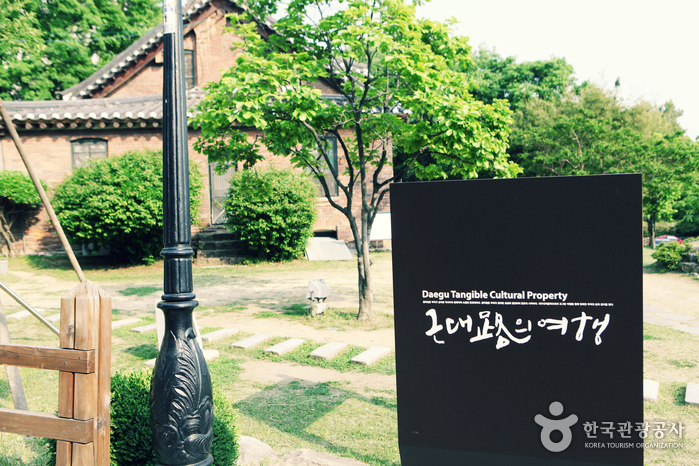See Channel Eyewear - Daegu Dongseong-ro Branch [Tax Refund Shop] (씨채널한일로안경 대구동성로)
396.9M 2024-04-19
604, Gukchaebosang-ro, Jung-gu, Daegu
-
Olive Young - Dongseongro Branch [Tax Refund Shop] (올리브영 대구동성로)
406.6M 2024-04-22
593, Gukchaebosang-ro, Jung-gu, Daegu
-
Daegu Jeil Church (대구제일교회)
416.8M 2024-10-11
50, Gukchaebosang-ro 102-gil, Jung-gu, Daegu
+82-53-253-2615
Daegu Jeil Church is the oldest Protestant Church in Gyeongsangbuk-do Province. Initially established in 1898 over four tile-roofed houses, Daegu Jeil Church was rebuilt in 1933 with traditional and Western architectural designs. Subsequently, Deacon Lee Ju-Yeol dedicated a 33m bell tower in 1937, whlie the church underwent an interior renovation in 1969, and an expansion in 1981.
In conjuction with its physical development, which was at the forefront of the nation's architectural modernization, the church contributed largely to modernization and expansion of Christianity in the region as well as in Korea. In addition, by introducing modern medicine and education to the citizens of Daegu, the founders of Daegu Jeil Church stimulated social development in the region.
Spark Land (스파크랜드)
428.7M 2024-07-05
61 Dongseong-ro 6-gil, Jung-gu, Daegu
Spark Land, nestled in downtown Daegu, is a dynamic fusion of a shopping mall and theme park. It boasts an array of attractions, including a fashion street, a selection of restaurants and cafés, amusement rides, and indoor sporting facilities. A standout feature is the Ferris wheel, uniquely designed with a reinforced glass floor, offering visitors a remarkable experience. From atop the Ferris wheel, panoramic views of Dongseong-ro Avenue and the wider Daegu cityscape unfold. As evening sets in, the Sky Lounge and Spark Sky are bathed in night lights, transforming the atmosphere into something even more enchanting.
Gyonam YMCA (교남YMCA)
432.7M 2023-01-20
22, Namseong-ro, Jung-gu, Daegu
Established in December 1921, the Gyonam YMCA Hall served as a gateway to the modern movement in Daegu. During the Japanese colonial period, it was a meeting place and a base for Christian national movements such as the Product Promotion Movement, the Christian Rural Movement, and the Singanhoe Movement. This hall is a two-story red brick building built by the American missionary Blair in 1914. It retains the characteristics of the 1910s and '20s masonry construction, such as decorating the first and second floors with cornices and securing a square window with arches. In the early days, it was used as a place for students' education, evening classes, and lectures.
Rodeo Eyewear - Daegu Dongseong-ro Branch [Tax Refund Shop] (로데오안경 대구동성로)
442.1M 2024-04-19
46, Dongseong-ro 4-gil, Jung-gu, Daegu
-
Arc'teryx [Tax Refund Shop] (ARCTERYX)
496.9M 2024-06-26
132, Gyeongsanggamyeong-gil, Jung-gu, Daegu
-
Daegu Modern History Streets (Tour of Modern Streets) (대구 근대골목(근대로의 여행))
520.4M 2023-10-27
66, Gukchaebosang-ro 102-gil, Jung-gu, Daegu
+82-53-661-3327
Daegu Modern History Streets is an experiential tour that brings the participants across Daegu’s alleyways and living history. During the Korean War, Daegu was much less damaged than other regions. Because of that, the city retains the changes in lifestyles before and after the war relatively well.
There are 13 courses in total, run by regional self-governance groups in Daegu, defined according to different themes and areas. The most popular among them is Course 2, the Modern Cultural Street, which takes visitors on a tour of major sites associated with Daegu’s modernity. Follow the retro aesthetics and the history of Daegu and Korea along places like Kyesan Catholic Church, Jeil Church, old houses, and the former Chinese Elementary School.
Note that multilingual tours are offered to international visitors in English, Japanese, and Chinese, in regular tours (14:00 every Saturday) and on-demand tours (available for groups of more than 5). Reservations are offered on the official website.
Daegu Modern History Museum (대구근대역사관)
531.3M 2025-08-11
67 Gyeongsanggamyeong-gil, Jung-gu, Daegu
+82-53-606-6430
Located in Pojeong-dong, Jung-gu, Daegu, the Daegu Modern History Museum was officially opened on January 24, 2011. The museum is housed in a building that is rich in history. First built by Japan in 1932 as a bank, the building was once a symbol of repression and exploitation during the Japanese colonial rule. Today, the building stands proudly as an educational site and bears the title of ‘Cultural Property No. 49’ in recognition of its historical and cultural significance.
The two-story museum (1,971 square meters) houses a permanent exhibition (1F), featured exhibition (2F), and a hands-on exhibition room and classroom for diverse cultural activities and lectures. The history exhibition features the lifestyle of Daegu citizens, local customs, and education of the late 19th century and the early 20th century.
Bongsan Cultural Center (봉산문화회관)
544.0M 2022-12-26
77, Bongsanmunhwa-gil, Jung-gu, Daegu
+82-53-661-3500
Bongsan Cultural Center is a comprehensive culture and arts complex located on Bongsan Culture Street in downtown Daegu. The center serves to provide cultural entertainment to the community as well as contribute to the development of traditional culture and local art. The center also provides opportunities for the public to participate in well-being recreational activities and acquire life-long education related to culture and arts.
The center has five modern exhibition halls (Exhibition Hall
No. 1-4 and Art Space) and two performance halls (Gaon Hall with 442 seats and Space Raon with 90 seats). As the center is located near Banwoldang Station (Daegu Subway Line 1), it is easily accessible by public transportation.
![See Channel Eyewear - Daegu Dongseong-ro Branch [Tax Refund Shop] (씨채널한일로안경 대구동성로)](http://tong.visitkorea.or.kr/cms/resource/54/2884054_image2_1.jpg)
![Olive Young - Dongseongro Branch [Tax Refund Shop] (올리브영 대구동성로)](http://tong.visitkorea.or.kr/cms/resource/37/2883937_image2_1.jpg)

![Rodeo Eyewear - Daegu Dongseong-ro Branch [Tax Refund Shop] (로데오안경 대구동성로)](http://tong.visitkorea.or.kr/cms/resource/19/2884119_image2_1.jpg)

 English
English
 한국어
한국어 日本語
日本語 中文(简体)
中文(简体) Deutsch
Deutsch Français
Français Español
Español Русский
Русский